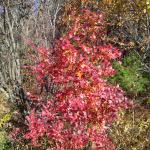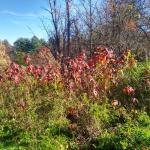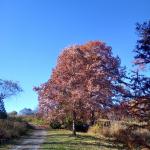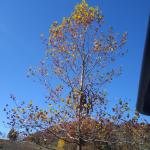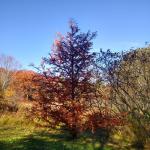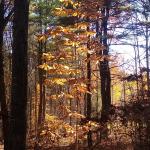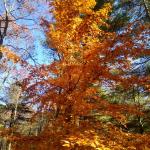UMass Extension's Landscape Message is an educational newsletter intended to inform and guide Massachusetts Green Industry professionals in the management of our collective landscape. Detailed reports from scouts and Extension specialists on growing conditions, pest activity, and cultural practices for the management of woody ornamentals, trees, and turf are regular features. The following issue has been updated to provide timely management information and the latest regional news and environmental data.
The Landscape Message will be updated once in November. The next message will be posted on December 2. To receive immediate notification when the next Landscape Message update is posted, be sure to join our e-mail list
To read individual sections of the message, click on the section headings below to expand the content:
Scouting Information by Region
Environmental Data
The following data was collected on or about November 2, 2022. Total accumulated growing degree days (GDD) represent the heating units above a 50º F baseline temperature collected via regional NEWA stations (http://newa.cornell.edu) for the 2022 calendar year. This information is intended for use as a guide for monitoring the developmental stages of pests in your location and planning management strategies accordingly.
|
MA Region/Location |
GDD |
Soil Temp |
Precipitation |
Time/Date of Readings |
|||||
|
4-Week Gain |
2022 Total |
Sun |
Shade |
||||||
|
CAPE |
186 |
2890 |
57 |
52 |
4.76 |
12:00 PM 11/2 |
|||
|
SOUTHEAST |
164.5 |
2970.5 |
64 |
55 |
4.55 |
3:00 PM 11/2 |
|||
|
NORTH SHORE |
130 |
2829 |
50 |
50 |
3.95 |
10:15 AM 11/3 |
|||
|
EAST |
160 |
3133 |
58 |
54 |
3.17 |
5:00 PM 11/2 |
|||
|
METRO |
114 |
2877 |
51 |
50 |
3.00 |
6:00 AM 11/2 |
|||
|
CENTRAL |
150 |
2928 |
55 |
54 |
3.65 |
2:00 PM 11/2 |
|||
|
PIONEER VALLEY |
117 |
2898.5 |
54 |
55 |
4.28 |
1:00 PM 11/2 |
|||
|
BERKSHIRES |
67 |
2339 |
54 |
52 |
3.34 |
6:00 AM 11/2 |
|||
|
AVERAGE |
136 | 2858 |
55 |
53 |
3.84 |
_ |
|||
|
* = information not available |
|||||||||
Regional Notes
Cape Cod Region (Barnstable)
General Conditions: The average temperature for the period from October 5 through November 2 was 56°F with a high of 75°F on October 12 and a low of 36°F on October 9. Frost was seen in low lying areas (cranberry bogs) on October 30 & 31, however no widespread frost has occurred yet. The past month has seen sunny and cloudy stretches, with sunny periods having daytime highs in the 60s and nighttime lows in the 40s. The cloudy days have primarily had highs in the 60s with warm nights remaining in the high 50s and 60s. The weather has been seasonal with fairly regular precipitation. The numerous rain events for the period added up to a total of 4.76 inches in Barnstable. Since rainfall amounts have varied across the Cape, some areas received significantly more than Barnstable. Soil moisture is adequate to excessive at this time. Some herbaceous plants seen in bloom include boneset (Eupatorium perfoliatum), Russian sage (Salvia yangii), Montauk daisy (Nipponanthemum nipponicum), Rudbeckia, goldenrods (Solidago spp.), mums (Dendranthema) and Asters. Some woody plants still flowering include butterfly bush (Buddleia davidii), autumn Clematis (Clematis terniflora), as well as some stress induced bloom on Rhododendron. Fall color is around peak and has been better than expected. Many lawns have rebounded with the return of cool and moist conditions.
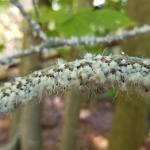 Pests/Problems: While the drought conditions have subsided, the drought damage to plants is still widely visible, particularly in Rhododendron which is showing a lot of dieback. Tupelo leafminer (Antispila nysaefoliella) damage is reducing foliage quality but does not significantly impact tree health. Oaks are also suffering from some leaf miner damage; solitary oak leafminer (Cameraria hamadryadella) damage has been seen on both white and black oaks. Symptoms of beech leaf disease have been found across much of the Cape this season from Sandwich to Provincetown, and can easily be seen at this time. Woolly beech aphid (photo left) has been seen in large populations on some beech. Hemlock woolly adelgid is active on hemlock. Other insect activity or damage observed during the period include chilli thrip damage on Hydrangea, lacebug damage Andromeda, boxwood leafminer damage on boxwood, prunicola scale on lilac and holly, and cottony camellia scale on Taxus. Seasonal needle loss on some white pine and pitch pine is excessive, possibly a result of pathogens or stress. Several plant samples with root rot symptoms have tested positive for Phytophthora in recent weeks. The combination of root damage from drought and now high soil moisture will encourage root rot pathogens. Pathogens and insects favored by drought damage and drought stress are likely to be on the rise and widespread next season.
Pests/Problems: While the drought conditions have subsided, the drought damage to plants is still widely visible, particularly in Rhododendron which is showing a lot of dieback. Tupelo leafminer (Antispila nysaefoliella) damage is reducing foliage quality but does not significantly impact tree health. Oaks are also suffering from some leaf miner damage; solitary oak leafminer (Cameraria hamadryadella) damage has been seen on both white and black oaks. Symptoms of beech leaf disease have been found across much of the Cape this season from Sandwich to Provincetown, and can easily be seen at this time. Woolly beech aphid (photo left) has been seen in large populations on some beech. Hemlock woolly adelgid is active on hemlock. Other insect activity or damage observed during the period include chilli thrip damage on Hydrangea, lacebug damage Andromeda, boxwood leafminer damage on boxwood, prunicola scale on lilac and holly, and cottony camellia scale on Taxus. Seasonal needle loss on some white pine and pitch pine is excessive, possibly a result of pathogens or stress. Several plant samples with root rot symptoms have tested positive for Phytophthora in recent weeks. The combination of root damage from drought and now high soil moisture will encourage root rot pathogens. Pathogens and insects favored by drought damage and drought stress are likely to be on the rise and widespread next season.
Southeast Region (Dighton)
General Conditions: The weather over the past few weeks has been grand. Several days of rain brought a total of about 4.5 inches. Daytime highs have been comfortably in the sixties and seventies. We haven't had a hard frost yet, although night time lows have been in the mid thirties. We're past peak color. The season was vivid despite the ravages of the dire summer drought. However, the ash and hickory trees have now dropped their leaves, as have the sugar maples and most of the swamp red maples. Norway maples are still holding yellow, while oaks are red, orange and brown. Cryptomeria, Chamaecyparis and other evergreens are shedding older foliage. Remaining grapes have turned into raisins. Not much is flowering except odd plants here and there that are 'mis-timed' such as: Rhododendron 'Olga Mezitt', Hydrangea macrophylla, Montauk daisy, and some persistent roses such as 'Knock Out' cultivars. Shortening day length is apparent in the morning, making us choose early chores that can be accomplished in low light. Lawns are still green and growing. Crabgrass has turned dark and gone to seed. Winter weeds such as Galium aparine (cleavers) have already germinated. Yellow common mullein and horsetail rosettes wait patiently for next spring. Cricket and katydid calls are fewer but still active and audible even during daylight hours. Dragonflies are still around as are cranefly adults.
Pests/Problems: Home invaders such as brown marmorated stink bug (Halyomorpha halys), western conifer seed bug (Leptoglossus occidentalis), Asian lady beetle (Harmonia axyridis), and various flies are common complaints from customers.
North Shore (Beverly)
General Conditions: Temperatures in the month of October were variable with day temperatures ranging from mid 50s to mid 74s. Night temperatures ranged from low 30s to mid 50s. The average daily temperature for the month was 53˚F, with the maximum temperature of 76˚F recorded October 7, and the minimum temperature of 27˚F recorded on October 29, 2022. Long Hill received 3.95 inches of much needed rainfall in the month of October. A storm came through on October 13 and 14 bringing rain and strong winds. The strong winds caused leaf drop and broken twigs. The few plants seen in bloom include: redbud hazel (Disanthus cercidifolius), American witch hazel (Hamamelis virginiana), Russian Daphne (Daphne x transatlantica), Japanese Anemone (Anemone x hybrida) and 'Sheffield Pink' Chrysanthemum (Dendranthema x grandiflorum - see photo, left). 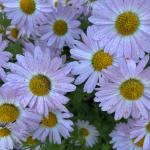 Fruiting plants such as hardy orange (Poncirus trifoliata), beautyberry (Callicarpa americana), Wright Viburnum (Viburnum wrightii) and winterberry (Ilex verticillata) are also providing color in the landscape with their fruits. Landscape professionals and homeowners are busy doing fall cleanup of leaves and twigs.
Fruiting plants such as hardy orange (Poncirus trifoliata), beautyberry (Callicarpa americana), Wright Viburnum (Viburnum wrightii) and winterberry (Ilex verticillata) are also providing color in the landscape with their fruits. Landscape professionals and homeowners are busy doing fall cleanup of leaves and twigs.
Pests/Problems: Ticks are still active and will remain active anytime the temperature is above freezing. Take precautions when raking leaves. Conduct tick checks after working outdoors. Use repellents containing DEET to protect yourself. Mosquito populations are mostly done for the year. Poison ivy (Toxicodendron radicans) and invasive species such as burning bush (Euonymus alatus) and Oriental bittersweet (Celastrus orbiculatus) are displaying fall foliage color and seeds in the woods. Weed piles of Oriental bittersweet should be bagged or burned for proper disposal. Avoid using Oriental bittersweet on wreaths and other decorative arrangements. Leaves and mummified fruit from crabapple trees that were diseased should be raked, removed and destroyed to reduce the amount of disease pathogens carried over to the next season. The leaves and mummified fruits should not be thrown into the compost pile. Fungi that cause leaf and fruit spots, can over-winter in infected debris in soil or under the plants. Keep evergreen shrubs well-watered. Deep late fall watering ensures that the roots of the shrubs take up enough water to keep them hydrated during the winter.
East Region (Boston)
General Conditions: October temperatures averaged 65°F with a high of 78°F on the seventh. Overnight lows averaged 46°F. We had several overnight temperatures in the 30’s but no killing frost. This most recent week, the days have been sunny with above average temperatures. We accumulated 3.35 inches of rainfall in October, making it the first month since February that we gained above historical monthly average precipitation. Fall color and leaf drop slowly continue. Perennial gardens continue to flower.
Pests/Problems: Winter/spring annuals chickweed (Stellaria spp.), spotted spurge (Euphorbia maculata) and groundsel (Senecio vulgaris) have germinated in mulched beds. Spring bulb foliage has prematurely emerged. Powdery mildew continues to attack residual foliage of lilac, peony and Phlox.
Metro West (Acton)
General Conditions: Mild, if not warm weather lingered into the month of October. A high of 74°F was recorded on the 12th and we closed out the month with temperatures approaching 70°F on both the 30th and 31st. Despite the summer’s drought conditions, the fall foliage did not disappoint. Much of it is now off the trees and on the ground. The average monthly precipitation for October is 4.40” and the total measured for the month was 3.19”. The first hard and killing frost was recorded on the morning of October 28th, but a lighter and first frost of the season was recorded on October 19th and several more have been recorded since then. The average monthly precipitation for the month of November is 3.61”. A few herbaceous perennial plants have been observed in bloom at this time of year including Aster tataricus (Tatarian Aster), Allium thunbergii ‘Ozawa’ (Japanese ornamental onion), and Nipponanthemum nipponicum (Montauk daisy/Nippon daisy).
Pests/Problems: Euonymus alatus (burning bush/winged euonymus), a non-native invasive woody plant, is very showy right now with its brilliant red foliage. It can be seen growing in landscapes as well as in the forest understory and along road sides. It’s hard to miss but please do not confuse it with Vaccinium corymbosum (highbush blueberry) a native shrub with very showy and spectacular red foliage on display as well right now.
Central Region (Boylston)
General Conditions: Seasonal changes continue to dramatically alter the landscape at New England Botanic Garden. From October 6th to November 2nd of 2022, the daily average ambient temperatures have undulated. Daily averages have been sitting between 40 and 60°F and the overall trend is moving downwards. The maximum ambient temperature was 79.7°F on 10/14, with a couple of days of highs at 75.9 and 76.1°F on 10/06 and 10/07. There have also been a couple of days below freezing at 31.9 and 32.1°F on 10/28 and 10/29. On October 20th and 21st, the lows did not dip below 60°F. Precipitation levels have varied as well. The following days saw precipitation levels above 0.5 inches: 10/09 (0.67 in), 10/10 (0.82 in) and 10/13 (0.61 in). Since then, temperatures have cooled, and precipitation has decreased. We are more than a third of our way through fall and a state of dormancy is beginning to settle into the plants and animals in the region. As of today, the foliage of deciduous shrubs and trees has mostly fallen. The leaves of Quercus and Betula spp. have persisted. Specifically, Quercus rubra (red oak), Q. bicolor (swamp white oak), and Fagus grandifolia (American beech) have lovely fall colors and will likely hold onto their leaves for the foreseeable future. Populus tremuloides (quaking aspen) has turned a lovely yellow color and the leaves, with their long, flattened petioles, shimmer in the fall winds. Lastly, Magnolia acuminata (cucumber Magnolia), M. macrophylla subspecies ashei (Ashe Magnolia) and Vaccinium corymbosum (highbush blueberry) leaves are vibrant colors of yellow and scarlet. The seed pods of Asclepius spp., Solidago spp., Aster spp. and Vernonia noveboracensis (New York ironweed) have emerged and will provide necessary forage for birds and other wildlife during the harsh winter months. [note of appreciation: The colorful photographs below were taken by Abrianna Culligan during the first week of November at New England Botanic Garden at Tower Hill.]
Pests/Problems: Pest problems in the region are minimal. Of note, there has been increased vole and aphid activity. Powdery mildew continues to evade our control. Euonymus alatus (burning bush) is a beautiful pinkish red color, and it has set seed as well.
Pioneer Valley Region (Amherst)
General Conditions: Late autumn has arrived in the Pioneer Valley as winter dormancy slowly takes over the landscape. As is often the case, October produced some beautiful weather and stunning foliage. Despite the heat and drought this summer, peak foliage was crisp and vivid. On the heels of a wet September, two big rain events were recorded at the Easthampton gauge on 10/5 (1.70”) and 10/13–14 (1.79”). Soils remain moist and it has been a great fall season for transplanting trees and shrubs. A number of frosts and gusty winds late in October accelerated leaf drop but the valley has yet to experience any temperatures lower than ~28°F. A few crickets can still be heard during the evening hours and mosquitoes are still lingering, illustrating the lack of cold temperatures. There has been a good deal of morning fog along the Connecticut River and its main tributaries in recent weeks as temperatures swing widely between the day and night. A four-day stretch of cloudy, warm and humid weather in late October deposited another 0.56” of rainfall. November is starting with some above-average temperatures and bright sun.
Pests/Problems: It was a challenging growing season for many landscape plants and we can only hope the late season rains and cooler temperatures have provided some measure of relief. Continue to ensure that newly transplanted evergreens have sufficient soil moisture through November. Now is a good time to start applying deer repellents to preferred plants, such as arborvitae (Thuja) and yew (Taxus). Depending on the level of local feeding pressure, it may be many weeks before deer begin browsing but it's best to be prepared. Apply these products at the high-labeled rate to maximize their ability to resist feeding. Return applications will be required during the winter months but only do so when temperatures are near and above freezing to avoid any contact freeze injury after application. Most deer repellents will also discourage rabbit browsing on plants ranging from young hemlock (Tsuga) to perennial succulents like Sempervivum. Bark guards should be used to protect the base of young, deciduous hardwoods in areas where voles are known to inhabit. Meadow voles (Microtus pennsylvanicus) will feed on bark during the winter months, especially under snow cover, girdling trees and shrubs. Shrews, chipmunks and moles do not cause a similar injury to woody plants. Foliage harboring foliar pathogens, like Venturia inaequalis (cause of apple scab), should be removed or mulched to accelerate decomposition. Many foliar pathogens overwinter on discarded leaves and when abundant at the site, can readily sporulate and infect newly developing foliage in the spring.
Berkshire Region (Great Barrington)
General Conditions: Overall, it has been a much milder span since the last report than one would expect at this time of year. The high temperature, as recorded at the three official weather-reporting sites in Berkshire County, all occurred on October 26. On that day, North Adams recorded 77°F, Pittsfield had 73°F, and Richmond reported 71°F. However, all 3 sites plus this scouting site in West Stockbridge experienced a hard freeze, i.e., 28°F or lower. Richmond had the lowest temperature of 25°F on October 29 and 30. North Adams temperature dipped to 27°F on those same days. West Stockbridge had a hard freeze of 27°F on October 9 and 28°F on October 29 and 30. Pittsfield had a low of 27°F on the 29th. Total rainfall from October 5 through November 1 was 2.25 inches at North Adams, 4.24 inches in Pittsfield, 4.03 inches in Richmond, and 3.34 inches at West Stockbridge. According to data recorded at the Pittsfield Airport, total rainfall year to date (November 1) is 33.18 inches, which is 4.02 inches below the normal year to date. Last year, total rainfall year to date was 48.98 inches, or 15.80 inches above normal. This does indicate that it has been a relatively dry year in the County in 2022. Yet, there have really been no long stretches without some rain. Except for plants on well-drained sites, there have been few sightings of drought stress. Fall foliage peaked over the weekend of October 22-23 and was particularly spectacular this year. 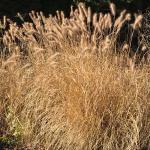 At this time, there is still some color but most deciduous species have dropped their leaves. There is still much attraction in herbaceous borders where ornamental grasses such as fountain grass (Pennisetum alopecuroides) - photo left - are quite showy as they sway with the breeze. Turfgrass growth has slowed but mowing may be required on well-irrigated lawns.
At this time, there is still some color but most deciduous species have dropped their leaves. There is still much attraction in herbaceous borders where ornamental grasses such as fountain grass (Pennisetum alopecuroides) - photo left - are quite showy as they sway with the breeze. Turfgrass growth has slowed but mowing may be required on well-irrigated lawns.
Pests/Problems: As one would expect, pest problems are minimal at this time of year. Nevertheless, black legged ticks abound and frequent sites where leaves have accumulated. Precautions should be taken when working at such sites. A common sight at this time of year is the box elder bug. They can be seen scurrying about in search of hiding places to overwinter. Often these places are buildings, including homes. BEBs become nuisance pests in the fall when they leave the plants to find hiding places for the winter. They’ll also hide in cracks in trees and around rocks. Much of the damage to landscapes now is the result of browsing by deer. Fawns are nearing maturity and join the does and bucks in munching on a wide variety of woody plants, especially plants that are somewhat succulent. Voles remain active and can be found tunneling near plants in beds and borders. They are also becoming a problem for those who grow or store plants in hoop houses or green tunnels. Foliar diseases are quite apparent on roses that still retain some of their leaves. Once they fall, these leaves should be collected and disposed of. This is also true of infected leaves from crabapples and all other plants that experienced disease.
Regional Scouting Credits
- CAPE COD REGION - Russell Norton, Horticulture and Agriculture Educator with Cape Cod Cooperative Extension, reporting from Barnstable.
- SOUTHEAST REGION - Brian McMahon, Arborist, reporting from the Dighton area.
- NORTH SHORE REGION - Geoffrey Njue, Green Industry Specialist, UMass Extension, reporting from the Long Hill Reservation, Beverly.
- EAST REGION - Kit Ganshaw & Sue Pfeiffer, Horticulturists reporting from the Boston area.
- METRO WEST REGION – Julie Coop, Forester, Massachusetts Department of Conservation & Recreation, reporting from Acton.
- CENTRAL REGION - Mark Richardson, Director of Horticulture reporting from New England Botanic Garden at Tower Hill, Boylston.
- PIONEER VALLEY REGION - Nick Brazee, Plant Pathologist, UMass Extension Plant Diagnostic Lab, reporting from Amherst.
- BERKSHIRE REGION - Ron Kujawski, Horticultural Consultant, reporting from Great Barrington.
Woody Ornamentals
Diseases
Recent pests and pathogens of interest seen in the UMass Extension Plant Diagnostic Lab, a select few:
- Black stain root disease of eastern white pine (Pinus strobus), caused by Leptographium procerum. The samples originated from a group of approximately 20 mature white pines that died in a state forest campground. The site is dominated by mature white pine with an assortment of mixed hardwoods. Upon initial investigation, there was evidence of bark beetle infestation and weeping resin on the lower trunks, with black-colored streaking in the vascular tissue at the base of the trees. Leptographium is considered a weak fungal pathogen but can be an important contributor to the decline and death of white pine when other stresses are present. Within infected sapwood in the roots and the lower trunk, the fungus produces masses of sticky spores that attach to colonizing insects, like borers and bark beetles. These insect vectors then disperse and introduce the pathogen into other weakened and stressed trees. As a vascular wilt pathogen, fungal colonization results in water starvation. Prior to death, many infected trees exhibit weak growth with stunted shoots and undersized needles. Sapwood in the main lateral roots and lower trunk often exhibits dark streaking and staining. From this symptomatic tissue, Leptographium was cultured in the laboratory. Leptographium is closely related to Ophiostoma and Ceratocystis, other vascular wilt pathogens of conifers and hardwoods in the region. Black stain root disease is often a cryptic disease and may be overlooked in the decline and death of many white pines in the region. Stem and branch samples were also submitted and these were harboring the white pine bast scale (Matsucoccus macrocicatrices) and Diplodia sapinea. When stressed, eastern white pine can be very susceptible to infection by Diplodia and the bast scale is known to create infection sites for cankering fungi to colonize.
- Shoot tip dieback of eastern hemlock (Tsuga canadensis), caused by transplant shock and Phomopsis stem cankering. The tree is approximately 10-years-old and was planted on a wooded edge with a mixture of sun and shade. The soils are described as a well-drained loam and drip irrigation was installed. In mid-September, premature needle shedding and shoot tip dieback developed. Eastern hemlock has very few associated diseases and Phomopsis is by far the most abundant fungal pathogen on samples submitted to the lab for analysis. In nearly every case, other stresses have weakened the trees, making them susceptible to infection.
- Stunted growth and canopy thinning in a mature eastern white pine (Pinus strobus) caused by Cytospora. The tree is approximately 80-years-old and resides in a woodland area bordering a managed landscape. The submitted shoots had undersized foliage that was browning and shedding prematurely. While Cytospora is uncommon on white pine samples submitted to the lab, the pathogen has a wide host range among landscape and forest conifers.
- Canopy dieback of Rhododendron (Rhododendron sp.) caused by Botryosphaeria. The plant is roughly 10- to 15-years-old and resides in a full sun landscape with sandy soils. In July of this year, a rapid leaf browning and dieback was observed in the canopy. The submitted branch sections had curled leaves and blackened stems with stained vascular tissue. After incubating several stem segments, an abundance of Botryosphaeria fruiting bodies ruptured through the bark. It’s likely that other stresses also contributed, such as drought or root disease, but those could not be confirmed from the sample.
- Needle blight of Japanese cedar (Cryptomeria japonica ‘Radicans’) caused by Phyllosticta. The tree is approximately 10-years-old and was transplanted three years ago about 10’ from a large overstory oak. Despite drip irrigation in this landscaped bed, the clay-based soils were described as very dry. In late summer, needle browning and branch dieback developed. Some excavation around the base of the tree revealed many dead roots as well. This particular case is a good example of how supplemental irrigation may not be providing adequate water to trees and shrubs. It’s important to know the volume of water these systems are applying over a given time period and the soil should be examined periodically to ensure its being properly wetted.
Report by Nick Brazee, Plant Pathologist, UMass Extension Plant Diagnostic Lab, UMass Amherst.
Insects
Upcoming Invasive Insect Educational Opportunities!
UMass Extension’s FREE Invasive Insect Webinar Series has returned for 2023! Join us in January and February for some excellent presentations about invasive insects and a non-insect (nematode). Pesticide contact hours (for all New England states for equivalent categories) and association credits will be available for participants who watch the LIVE webinars on:
January 25, 2023:
-
Forest Pest Risk is Heating Up with Climate Change
Audrey Barker-Plotkin, Senior Scientist and Site & Research Manager, Harvard Forest -
Spotted Lanternfly Updates for Massachusetts from MA Department of Agricultural Resources
Elizabeth Barnes, Forest Pest Outreach Coordinator, MA Department of Agricultural Resources
February 8, 2023:
-
Spotted Lanternfly Management in the Landscape
Brian Walsh, Extension Educator, Ornamentals, PennState Extension -
Entomopathogens of Spotted Lanternfly, Biopesticides, & Scouting Egg Masses in Vineyards
Dr. Eric Clifton, Research Scientist, BioWorks
February 22, 2023:
-
Beech Leaf Disease: and the Newly Described Nematode That Causes It
Dr. Robert Marra, Associate Agricultural Scientist, Connecticut Agricultural Experiment Station -
Invasive Forest Insects in Massachusetts
Nicole Keleher, Director, MA Department of Conservation and Recreation, Forest Health Program
For more information and to register, visit: https://ag.umass.edu/landscape/education-events/invasive-insect-webinars
These webinars are part of a FREE series supported by the Specialty Crop Block Grant Program at the U.S. Department of Agriculture through grant 21SCBPMA1011. Its contents are solely the responsibility of the presenters and do not necessarily represent the official views of the USDA.
Insects and Other Arthropods
-
Mosquitoes: The Massachusetts Department of Public Health has reported (as of 11/1/2022) seven human cases of West Nile virus (WNV) in Massachusetts in 2022. As of 11/1/2022 there have been no eastern equine encephalitis (EEE) cases. The MA Department of Public Health tests for WNV and EEE from June to October. Testing summaries for 2022 can be found here: https://www.mass.gov/info-details/massachusetts-arbovirus-update . With the onset of frost, mosquito encounters have greatly diminished. However, on mild days, the occasional mosquito can be seen flying by.
-
Deer Tick/Blacklegged Tick: Just because the leaves have fallen, doesn’t mean tick exposure risk has. Deer tick adults and nymphs continue to be encountered in the fall, and adults may be encountered throughout the winter any time temperatures are above freezing. Continue to monitor yourself with regular tick-checks if working or playing in tick habitat.
Ixodes scapularis adults are active all winter and spring, as they typically are from October through May, and “quest” or search for hosts at any point when daytime temperatures are above freezing. Engorged females survive the winter and will lay 1,500+ eggs in the forest leaf litter beginning around Memorial Day (late May). Larvae are encountered in New England from roughly May through November, with peak risk reported in August. Nymphs are encountered from April through July with a peak risk reported in June in New England. Nymphs may also be encountered again in October and November. For images of all deer tick life stages, along with an outline of the diseases they carry, visit: https://web.uri.edu/tickencounter/species/blacklegged-tick/ .
Anyone working in the yard and garden should be aware that there is the potential to encounter deer ticks. The deer tick or blacklegged tick can transmit Lyme disease, human babesiosis, human anaplasmosis, and other diseases. Preventative activities, such as daily tick checks, wearing appropriate clothing, and permethrin treatments for clothing (according to label instructions) can aid in reducing the risk that a tick will become attached to your body. If a tick cannot attach and feed, it will not transmit disease. For more information about personal protective measures, visit: https://web.uri.edu/tickencounter/prevention/protect-yourself/
The Center for Agriculture, Food, and the Environment provides a list of potential tick identification and testing resources here: https://ag.umass.edu/resources/tick-testing-resources .
Woody ornamental insect and non-insect arthropod pests to consider, a selected few:
Invasive Insects & Other Organisms Update:
-
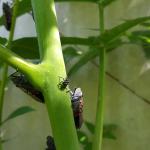

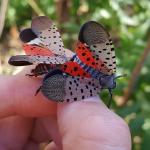
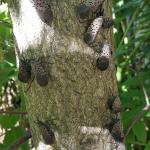
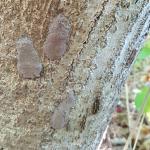 Spotted Lanternfly: (Lycorma delicatula, SLF) is a non-native, invasive insect that feeds on over 103 species of plants, including many trees and shrubs that are important in our landscapes.
Spotted Lanternfly: (Lycorma delicatula, SLF) is a non-native, invasive insect that feeds on over 103 species of plants, including many trees and shrubs that are important in our landscapes.
As of 11/1/2022, the only established populations of spotted lanternfly in Massachusetts are in Fitchburg, Shrewsbury, and Worcester, MA (Worcester County) and Springfield, MA (Hampden County). Therefore, there is no reason to be preemptively treating for this insect in other areas of Massachusetts. If you suspect you have found spotted lanternfly in additional locations, please report it immediately to MDAR here: https://massnrc.org/pests/slfreport.aspx . If you are living and working in the Fitchburg, Shrewsbury, Worcester, and Springfield areas, please be vigilant and continue to report anything suspicious.
For individuals living and working in areas of MA with established spotted lanternfly populations, UMass Extension and the MA Department of Agricultural Resources have created a *NEW* spotted lanternfly management fact sheet that is now available here: https://ag.umass.edu/landscape/fact-sheets/spotted-lanternfly-management . This resource may be helpful for anyone monitoring and potentially managing SLF in these areas next season.
For More Information:
From UMass Extension:
Check out the InsectXaminer Episode about spotted lanternfly adults and egg masses! Available here: https://ag.umass.edu/landscape/education-events/insectxaminer
Fact Sheet: https://ag.umass.edu/landscape/fact-sheets/spotted-lanternfly
*NEW*: Management Fact Sheet: https://ag.umass.edu/landscape/fact-sheets/spotted-lanternfly-management
*NEW*: Center for Agriculture, Food, and the Environment: https://ag.umass.edu/news-events/highlights/spotting-spotted-lanternfly
From the MA Department of Agricultural Resources:
Fact Sheet and Map of Locations in MA: https://massnrc.org/pests/pestFAQsheets/spottedlanternfly.html
-
Asian Longhorned Beetle: (Anoplophora glabripennis, ALB) Look for signs of an ALB infestation which include perfectly round exit holes (about the size of a dime), shallow oval or round scars in the bark where a female has chewed an egg site, or sawdust-like frass (excrement) on the ground nearby host trees or caught in between branches. Be advised that other, native insects may create perfectly round exit holes or sawdust-like frass, which can be confused with signs of ALB activity.
The regulated area for Asian longhorned beetle is 110 square miles encompassing Worcester, Shrewsbury, Boylston, West Boylston, and parts of Holden and Auburn. If you believe you have seen damage caused by this insect, such as exit holes or egg sites, on susceptible host trees like maple, please call the Asian Longhorned Beetle Eradication Program office in Worcester, MA at 508-852-8090 or toll free at 1-866-702-9938.
To report an Asian longhorned beetle find online or compare it to common insect look-alikes, visit: http://massnrc.org/pests/albreport.aspx or https://www.aphis.usda.gov/pests-diseases/alb/report .
-
Browntail Moth: Euproctis chrysorrhoea is an invasive insect originating from Europe and first detected in the US in Somerville, MA in 1897. Currently, browntail moth is limited to a small portion of eastern Massachusetts, particularly areas near the coast. Report suspected browntail moth life stages here: https://massnrc.org/pests/pestreports.htm . Due to a persistent outbreak of this insect in Maine since approximately 2016, it is a good idea for us to again familiarize ourselves with this pest.
Now is the time of year where professionals and homeowners can be on the lookout for browntail moth “winter webs”. These are the webs within which the caterpillars which hatched from eggs laid in 2022 will spend the winter, often at the very tips of host plant branches (ex. red oak or apple). For an excellent video of browntail moth winter webs and what to look for from the Maine Forest Service
. Anyone who sees browntail moth winter webs in Massachusetts should report them to the link above.
Caution: hairs found on the caterpillar and pupal life stages of this insect can cause a rash similar to poison ivy. Some individuals are very sensitive to browntail moth hairs and may also experience allergic reaction. The chance of interacting with browntail moth hairs increases between May and July, although they could be a problem at any time of year.
-
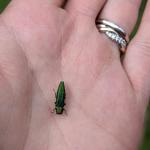 Emerald Ash Borer: (Agrilus planipennis, EAB) has been detected in at least 11 out of the 14 counties in Massachusetts. A map of these locations across the state. Additional information about this insect is provided by the MA Department of Conservation and Recreation.
Emerald Ash Borer: (Agrilus planipennis, EAB) has been detected in at least 11 out of the 14 counties in Massachusetts. A map of these locations across the state. Additional information about this insect is provided by the MA Department of Conservation and Recreation.
This wood-boring beetle readily attacks ash (Fraxinus spp.) including white, green, and black ash and has also been found developing in white fringe tree (Chionanthus virginicus) and has been reported in cultivated olive (Olea europaea). Signs of an EAB infested tree may include D-shaped exit holes in the bark (from adult emergence), “blonding” or lighter coloration of the ash bark from woodpecker feeding (chipping away of the bark as they search for larvae beneath), and serpentine galleries visible through splits in the bark, from larval feeding beneath. It is interesting to note that woodpeckers are capable of eating 30-95% of the emerald ash borer larvae found in a single tree (Murphy et al. 2018). Unfortunately, despite high predation rates, EAB populations continue to grow. However, there is hope that biological control efforts will eventually catch up with the emerald ash borer population and preserve some of our native ash tree species for the future. For an update about the progress of the biological control of emerald ash borer, visit Dr. Joseph Elkinton’s archived 2022 webinar.
-
Jumping Worms: Amynthas spp. earthworms, collectively referred to as “jumping or crazy or snake” worms, overwinter as eggs in tiny, mustard-seed sized cocoons found in the soil or other substrate (ex. compost) that are impossible to remove. Adult and juvenile jumping worms are killed with the frost and do not overwinter in New England.
For More Information:
UMass Extension Fact Sheets:
*NEW* Resource with Over 70 Questions and their Answers: Invasive Jumping Worm Frequently Asked Questions
Earthworms in Massachusetts – History, Concerns, and Benefits
Jumping/Crazy/Snake Worms – Amynthas spp.
A Summary of the Information Shared at UMass Extension’s Jumping Worm Conference in January 2022
Tree & Shrub Insect Pests, Continued:
- Fall Home-Invading Insects: Various insects, such as ladybugs, boxelder bugs, seedbugs, and stink bugs (including the invasive brown marmorated stink bug) will seek overwintering shelters in warm places, such as homes. While such invaders do not cause any structural damage, they can become a nuisance especially when they are present in large numbers. A vacuum with a bag that can be emptied is a handy way to dispose of any such unwanted invaders.
- Hemlock Woolly Adelgid: Adelges tsugae is present on eastern and Carolina hemlock. The overwintering hemlock woolly adelgid generation (sistens) is present through mid-spring and produces the spring generation (progrediens) which will be present from early spring through mid-summer. HWA, unlike many other insects, does most of its feeding over the winter. Eggs may be found in wooly masses at the base of hemlock needles beginning in mid-March. Each wooly mass is created by a female who may then lay 50-300 eggs. Eggs hatch and crawlers may be found from mid-March through mid-July. Infested trees may be treated with foliar sprays in late April to early May, using Japanese quince as a phenological indicator. Systemic applications may be made in the spring and fall, or when soil conditions are favorable for translocation to foliage. Nitrogen fertilizer applications may make hemlock woolly adelgid infestations worse.
Concerned that you may have found an invasive insect or suspicious damage caused by one? Need to report a pest sighting? If so, please visit the Massachusetts Introduced Pests Outreach Project: http://massnrc.org/pests/pestreports.htm .
Reported by Tawny Simisky, Extension Entomologist, UMass Extension Landscape, Nursery, & Urban Forestry Program
Additional Resources
Pesticide License Exams - The MA Dept. of Agricultural Resources (MDAR) is now holding exams online. For more information and how to register, go to: https://www.mass.gov/pesticide-examination-and-licensing.
To receive immediate notification when the next Landscape Message update is posted, join our e-mail list or follow us on Facebook.
For a complete listing of upcoming events, see our upcoming educational events https://ag.umass.edu/landscape/upcoming-events
For commercial growers of greenhouse crops and flowers - Check out UMass Extension's Greenhouse Update website
For professional turf managers - Check out Turf Management Updates
For home gardeners and garden retailers - Check out our home lawn and garden resources.
Diagnostic Services
UMass Laboratory Diagnoses Landscape and Turf Problems - The UMass Extension Plant Diagnostic Lab is available to serve commercial landscape contractors, turf managers, arborists, nurseries and other green industry professionals. It provides woody plant and turf disease analysis, woody plant and turf insect identification, turfgrass identification, weed identification, and offers a report of pest management strategies that are research based, economically sound and environmentally appropriate for the situation. Accurate diagnosis for a turf or landscape problem can often eliminate or reduce the need for pesticide use. For sampling procedures, detailed submission instructions and a list of fees, see Plant Diagnostic Laboratory
Soil and Plant Nutrient Testing - The University of Massachusetts Soil and Plant Nutrient Testing Laboratory is located on the campus of The University of Massachusetts at Amherst. Testing services are available to all. The lab provides test results and recommendations that lead to the wise and economical use of soils and soil amendments. For more information, including current turn-around times, visit the UMass Soil and Plant Nutrient Testing Laboratory web site. The lab is currently accepting new orders for Routine Soil Analysis (including optional Organic Matter, Soluble Salts, and Nitrate testing), Particle Size Analysis, Pre-Sidedress Nitrate (PSNT), and Soilless Media (no other types of soil analyses available at this time). Turnaround time: Please plan for the fact that date of receipt in the lab is affected by weekends, holidays, shipping time, and time for UMass Campus Mail to deliver samples to the lab.
Tick Testing - The UMass Center for Agriculture, Food, and the Environment provides a list of potential tick identification and testing options at: https://ag.umass.edu/resources/tick-testing-resources.
Acknowledgements: UMass Extension gratefully acknowledges the support of the following funding sources for the production of the Landscape Message –
- The Massachusetts Nursery and Landscape Association Fund
- The Massachusetts Department of Conservation and Recreation, Award #ISADCR28219926UMA22A
- Stakeholders like you! The Landscape Message is partially supported by educational program user fees.
